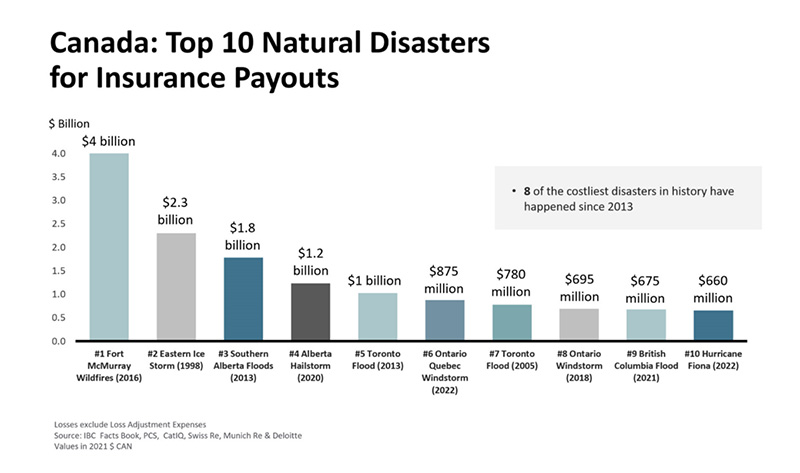
Hurricane Fiona causes $660M in insured damage: IBC
October 25, 2022
By Insurance Bureau of Canada
Storm is the costliest extreme weather event ever recorded in Atlantic Canada.
 Graphic: Insurance Bureau of Canada
Graphic: Insurance Bureau of Canada Hurricane Fiona is estimated to have caused $660 million in insured damage, according to initial estimates from Catastrophe Indices and Quantification Inc. (CatIQ).
Hurricane Fiona is the most costly extreme weather event ever recorded in Atlantic Canada and the tenth largest in Canada in terms of insured damages – surpassing the 2011 Slave Lake wildfire. This long-lived and powerful storm first made landfall in Atlantic Canada on Saturday Sept. 24, 2022. With maximum wind gusts exceeding 100 km/h in Atlantic Canada and Eastern Quebec, Hurricane Fiona resulted in tragic loss of life as well as violent winds, torrential rainfall, large waves, storm surge, downed trees and widespread power outages.
Although the estimated $660 million in insured damage is a record-breaking figure, many affected residents were located in high-risk flood areas and floodplains where residential flood insurance coverage is not available. As a result, the overwhelming majority of costs for this disaster will be borne by government.
“As we begin to see the extent of damages caused by Hurricane Fiona, it is clear that much more needs to be done to enhance our resilience to extreme weather events and build a culture of preparedness moving forward,” said Amanda Dean, vice-president, Atlantic, Insurance Bureau of Canada (IBC). “Climate change is real, and the fatalities, emotional turmoil and financial consequences we’ve witnessed must be a call to action – we must prioritize the protection of all Canadians from the impacts of climate change.”
Insurance claims from severe weather have more than quadrupled across Canada since 2008. The new normal for insured catastrophic damages in Canada has reached $2 billion annually. IBC continues to advocate for governments to act on the urgent need to do more to prioritize investments that build resilience and better protect families and communities from a changing climate.
IBC has been leading conversations with the federal and provincial governments on ways to better protect communities moving forward and to better manage the costs of flooding for high-risk residential properties in Canada. As a member of the federal, provincial and territorial Task Force on Flood Insurance and Relocation, IBC has put forward options to create a residential flood insurance program – including a public-private partnership model – that would make affordable insurance available to residents of high-risk areas. These recent floods are a reminder of the urgency with which we must move forward in those discussions.
Canada must prioritize its work on a national adaptation strategy, including a high-risk flood insurance pool, to address climate-related disasters such as extreme heat, wildfires, floods, windstorms and hail. Increased collaboration across the public and private sectors is essential to defending Canadians from these events.
The following is a provincial breakdown of insured damage estimates from Hurricane Fiona:
Nova Scotia – Over $385 million in insured damages:
In Nova Scotia, damage to trees was widespread, with numerous large trees falling on cars and buildings in Halifax. Cape Breton Island and Pictou County saw significant damage, including extensive flooding, roofs torn off buildings, roads washed out and storm surge. Power outages topped 415,000 customers in Nova Scotia on Saturday, September 24, leaving about 80% of the province without power.
Prince Edward Island – Over $220 million in insured damages:
Hurricane Fiona extensively impacted Prince Edward Island, with damage reported across the entirety of the island. Damages included houses being moved off their foundations by storm surge and roofs being torn off buildings by wind. Trees and power lines were damaged or snapped/uprooted across the island, leaving 82,000 customers without power by Sunday, September 25. This accounts for 95% of total customers on the island. Significant beach erosion also impacted much of the north coast.
New Brunswick – Over $30 million in insured damages:
New Brunswick was spared much of the damage caused by Hurricane Fiona due to the easterly track of the storm. However, the province still experienced widespread power outages in Saint John, Fredericton, Moncton and the Acadian Peninsula. Damage to structures was largely located along the Northumberland Strait and near the Nova Scotia border, with large downed trees and branches.
Quebec – Over $11 million in insured damages:
The Iles-de-la-Madeleine saw extensive flooding, with many homes and businesses flooded to a depth of several feet. Storm-surge-related flooding and erosion from large waves were reported along parts of the Gaspé Peninsula coast.
Newfoundland and Labrador – Over $7 million in insured damages:
Southwestern Newfoundland was particularly hard-hit by Hurricane Fiona, with severe damage being reported from Burgeo to Port aux Basques. At least 20 homes were washed into the ocean by the storm, primarily in Port aux Basques, which led to evacuation orders during the morning of Saturday, September 24. The evacuation led to nearly 200 people being displaced by the storm. One fatality was confirmed in the town after a home collapsed into the sea amid intense wave action and storm surge. Homes were also destroyed in Burgeo, Burnt Islands and Fox Roost, where multiple buildings were destroyed by waves and storm surge.
Anyone who has been impacted by this event or who has questions about their home, vehicle or business insurance, should call their insurance representative or IBC’s Consumer Information Centre at 1-844-2ask-IBC.
The amount of insured damage is an estimate provided by CatIQ (www.catiq.com) under license to IBC.
Print this page